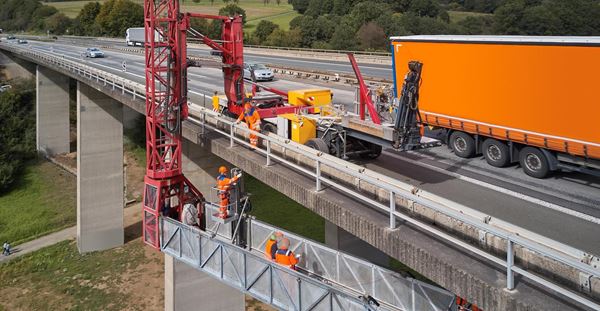In recent years Australia has experienced a boom in infrastructure investment. With this slowing down the focus is now shifting to maintaining these assets to maximise their longevity, value and purpose as the world looks towards a net zero future.
These challenges are common across the globe with aging workforces, outdated assets, reduced funding for asset performance and increasing regulatory and compliance requirements. On top of this, we need to satisfy complex stakeholder demands and provide sustainable solutions. So how do we best approach the changing dynamics of asset management?
During my recent trip to Australia, discussions with some major building and infrastructure management companies, asset management and city councils and fellow Arcadians revealed a few key themes. These included the long-term optimisation of asset management, asset resilience to climate change and adapting asset management methods towards achieving net zero goals. Shifting funds to best manage the asset base and integrating digital technology and tools to manage large and complex data sets were also key topics.
Leveraging existing investments for the next 100 years
Asset management is multi-faceted, involving much more than purely maintaining physical assets. Key to success is ensuring that all relevant disciplines within an organisation are part of an integrated framework that is supported by systems, processes, intelligence and tools working seamlessly together. When all these elements are in place we can listen and respond to stakeholders and react to societal, environmental or economic disruptions and create the best value from an asset.
To achieve long-term success, it is essential to plan, create alignment between strategy and operations, break down silos and build resilience. Leveraging artificial intelligence and digital tools is beneficial as they serve as co-pilots while keeping people skilled and empowered.
Keeping assets sustainable and resilient
In my conversations with people in Sydney dealing with assets on a maintenance or policy level, several were actively dealing with climate-related issues. In Australia, as in many other parts of the world, they were experiencing flash flooding and rising sea water levels, which could have a major impact on their coastal asset base.
Traditionally, big asset-owning organisations had separate departments for asset building and maintenance. Now, we are shifting more to a single asset management department which governs the entire asset lifecycle, enabling portfolio risk assessments. This allows important external influences like climate change to be considered upfront rather than as an afterthought.
Asset managers have acknowledged the complexity of overseeing the entire asset portfolio and require sophisticated algorithms to help with data collection and management. The introduction of solutions like Enterprise Decision Analytics has helped assess risks and prioritise actions when funds are limited.
That is where investing in moving towards net zero becomes essential - if you do not accelerate to a planet positive future, the expenditures on addressing those risks of changes to asset bases will become so high that you fall behind.

With these rapid changes, organisations need to assess and plan for the environmental and societal impacts and ensure agile decision-making is in the mix. They need to drive programmes to integrate impact assessments into core decision-making. I see the sustainability / ESG department becoming more and more integrated with the asset management core teams.
This integrated decision-making in asset management should be a driver for investments in solutions. For example, design standards, tools, inspection intervals, maintenance and operations procedures, skillsets and training will become outdated more rapidly in the future than we are currently experiencing.
Breaking down silos to best fund an asset base
Effective financial management of assets requires collaboration across different business functions to achieve the best results. By merging the strategy and costs between capital expenditure and operational expenditure, organisations can assess the value of all interventions in the lifecycle of an asset and optimise who can best shoulder the risk versus cost. If we allow silos to persist, the asset management backlog will continue to grow.
Capital expenditures should be sustainable and resilient. This means investing not only in physical assets but also in the drivers that keep the asset delivering on its purpose. Provide appropriate training, reduce future maintenance impact, build a digital profile and invest in digital infrastructure.
Further, maximising the value of existing assets is crucial when funding is limited. In some cases, tweaking existing assets can be cheaper and more sustainable than building new ones. It comes down to aligned decision-making to enhance an asset’s lifespan. For this to be successful 'line of sight' is crucial, so decisions at the top level should align with the entire organisation. In the railway industry, this is known as 'boardroom to ballast’. This approach helps everyone understand the collective purpose and why repairs may be necessary, creating ownership and a proactive culture at all levels in the asset management organization unlocking value on both asset and business level.
Digital and human innovations driving efficiencies
As human labour becomes harder to come by, we will see an increase in digitisation to support the long-term management of assets and asset data sets and enable our current and future asset management professionals to be more innovative and productive.
In the past years we have seen The Internet of Things (IoT) gaining momentum, facilitating the monitoring of assets, so much of this work will become ‘hands off eyes on’. We will be moving to proactive, predictive and prescriptive instead of reactive. Predictive means making an analysis using the available data gathered by technology and then predicting where the failure will hit just before it happens so you can maintain it or repair it proactively and in a more automated way.
Over the last decade or so, drones have been used to review the condition of assets. Arcadis offers a service in partnership with Niricson, Bridge Health, that uses drones to test and monitor the condition of bridges. Technology attached to the drone can see beneath the surface to assess and monitor damage. This is a great example of technology stretching the boundaries of data processing capabilities and detecting the necessary repairs before any visible surface damage appears. The emergence of advanced technologies has revolutionised the way organisations manage their large and complex asset data.
Leveraging these technologies such as Regenerative AI, Machine Learning, Advanced Analytics, Robotics, Digital Twins as well as many others, are providing organisations with the necessary tools and support required to effectively manage their asset data, and enhancing decision-making capabilities helping professionals to work safer, faster and smarter.
Long-term planning and adapting to rapid change
In Australia, my observation is that a lot of assets have been purpose-designed and built for specific reasons, but after having several in depth discussions with asset management organisations, things will be designed to have different functions in the future, prolonging the life of the assets.
For example, in one of my visits to a road asset manager, we discussed how the large jet fans in road tunnels that blow away Carbon Dioxide emissions are very costly and logistically challenging to maintain or repair. They are difficult to access and are very heavy. However, as we start to see more electric vehicles on the road, their primary function will eventually become redundant. So, this is where long-term planning and a good focus on the purpose and life-cycle performance of the asset and how you place, update and delete that in the management system will become increasingly important.

The future of asset management in Australia is looking positive, but it's crucial to understand and keep up with rapid change. To succeed, it is imperative to connect, integrate and align your strategies accordingly. Above all, be willing to embrace new digital technologies as co-pilots empowering our human capabilities to futureproof assets and ensure sustainable value from assets to accelerate to a planet positive future.









